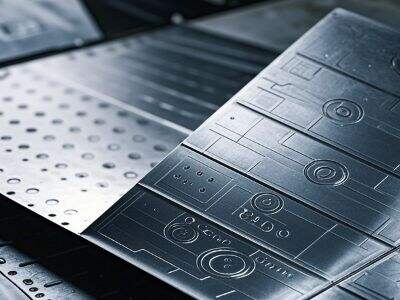Աշխատելուն մետաղի հետ ավարտական և բարդ գործ է կարող լինել։ Բայց չեք սպանդիրեք։ Երբ ունեք ճիշտ տեղեկատվություն, կարող եք դառնալ լուծելու ամենալավ եղանակը՝ ձեր կիրառումների համար մետաղը ձեռնարկելու համար։ Որոշ ընթերցողներ ցանկանում են իմանալ, թե ինչու է այն այնքան կարևոր ճիշտ եղանակը ընտրելու համար ձեռնարկման ժամանակ։ Թերթիկ Մետաղ նա նաև կ尻անակացնի օգտագործելի տիպեր, որոնք կօգնեն ձեզ ամենալավ որոշում ընտրել ձեր պահանջների համար։
Ճիշտ եղանակը ընտրելու համար մետաղի ձեռնարկում
Կան շատ տեխնոլոգիաներ, որոնք կարող են օգնել ձեզ փոխել մետաղի ձևը՝ ձեր ցանկացած ձևով, այնպես որ կարող է մնալ անհայտ, թե ինչ պետք է օգտագործել։ Լավագույն եղանակը ընտրելու համար կկարելի է կախված մի քանի հատուկ դիտարկումներից՝ ինչպիսի մետաղ է ձեզ անհրաժեշտ, ինչ ձև ցանկանում եք իրականացնել և ինչպես կօգտագործեք ավարտված արտադրանքը։ Մետաղը կարող է ձեռնարկվել տարբեր եղանակներով, ներառյալ ձուլում, ձեռնարկում, մարտահանում և այլն։
Ձուլում. Սա այն է, երբ վերցնում եք հեռացած մետաղ և լցնում մոլդում, որը ձևավորված է այն ձևով, որն է ցանկանում ձեր վերջնական հատվածը ունենալ։ Երբ CNC մետաղական մասեր սառուցում և կոնսերվացում է, ունի մոլդի ձևը: Սառուցումը լավ է մասնիկների համար, որոնք ունեն շատ մանրամասներ։
Դեղագործություն. Մետաղը ջերմացվում է արդյոք ջերմաստիճաններին և հետո դուրս է բաժանվում մոլդի մեջ։ Դեղագործությունը հայտնի է որպես գործընթաց, որը ստեղծում է շատ ուժուն մետաղական մասնիկներ, քանի որ գործընթացը կարող է ուղղագրել մետաղի թերին ուղղակի ուղղությամբ։
Պատրաստում. Սա մեխանիկական գործընթացն է՝ սեղմելով մետաղի աղյուսակը ձևի մեջ։ Ավարտական օգտագործումով, սա օգտագործվում է մասնիկների բարձր տարածությամբ մարգարդակցման համար։
Ինչ է Մետաղ-Հանգույցի Կարևորությունը Նշանակող Մեթոդով
Ընտրելով լավագույն մեթոդը մետաղի ձևավորման համար՝ դա կարևոր է ձեր պրոեկտի հաջողության համար։ Այսպիսով, ընտրելով ճիշտ մեթոդը՝ ապահովում է, որ ձեր մետաղական մասնիկը ունի ճիշտ հատկությունները, որոնք ձեզ անհրաժեշտ են՝ ուժ, կարողություն և կորոզիայի հակառակություն։ Այս ապարատները կարևոր են՝ համոզվելու դրան, որ ձեր պրոեկտը աշխատում է անգամ։
Դիտարկվող մեթոդը հանգում է ավելի պարզ և արագ ստեղծագործական գործընթաց։ Ճիշտ մեթոդը կհամապատասխանի ձեր պահանջներին, և հուսով օգնի ձեզ նվազեցնել հանգույցը և հասնել նպատակներին։
Գտնել Ձեր և Ձեր Պրոեկտի Համար Լավագույն Մոտեցումը
Երբ որոշում եք պրոեկտի համար մետաղը ձևավորելու օպտիմալ մեթոդը, կա շատ ինչ դիտարկել։ Այստեղ են մի քանի կարևոր հաշիվներ՝ մտահոգի մնալու համար։
Մետաղի Տիպը. Դուք առաջնահերթ կօգտագործեք մետաղի տիպը՝ որը կուղերցի ձեր որոշումները ձևավորելու մասին։ Օրինակ, եթե աշխատում եք ալյումինի կամ բրոնզով, 白沙 ձևավորումը ընդհանուրապես ամենաարդյոք եղանակն է։ Բայց եթե աշխատում եք արծաթով, ավելի արդյոք է օգտագործել գումարելի ձևավորումը։
Կոմպլեքսությունը՝ կախված է նաև ձեր ստեղծելու ցանկացած մասի կոմպլեքսությունից։ Եթե ձեր մետալական մասը բազմադետալավոր և բարդ ձև ունի, ապա անհրաժեշտ է ընտրել ավելի գնահատված գործընթաց, օրինակ՝ մոլդավոր լեռնային ձևավորում։ Այսպիսով, կարող եք համոզվել, որ բոլոր մանրամասներն արտաքինացված են ճիշտ։
Ստեղծելիս մասերի քանակը՝ պետք է որոշեք, թե քանի՞ մասեր եք պատրաստում, քանի որ դա կազմում է ձեր որոշումը։ Մեծ մասերի քանակի դեպքում հաճախ ընտրվում է մոլդավոր ձևավորումը։ Դա թույլ է տալիս արագ ստեղծել շատ մասեր։ Բայց պարզապես՝ եթե ձեզ պահանջվում են մի քանի մասեր, ապա լեռնային ձևավորումը ավելի արդյունավետ է փոքր հատումների դեպքում։
Տարբեր եղանակներ մետալի ձևավորման համար
Մետաղը կարող է ենթարկվել շատ մեթոդներին, որոնք ունեն իրենց առավելություններ և թերություններ։ Ներքևում մոտեցված են որոշ հատուկ մեթոդները՝
Կորուստական ձևավորում: Այս գործընթացում խորացված մետաղը լցվում է կրկինօգտագործելի ձևից, որը հաճախ կազմված է մետաղներից կամ կարմիրից: Սա օգնում է նվազեցնել նյութերի բացակայությունը և թույլ է տալիս պատրաստել մեծ տոնների նույնական մասեր համառոտ արտադրության համար:
Sha Casting: Այստեղ ձևը կազմված է 白沙-ից, և խորացված մետաղը լցվում է նրա մեջ՝ ստանալով ցանկացած ձև: Sha casting-ը հաճախ օգտագործվող գործընթաց է, քանի որ այն շատ համարյալ է, ինչպես նաև կարող է ստեղծել շատ մեծ կոմպոնենտներ մանր մանրությամբ:
Investment Casting: Այս գործընթացը օգտագործվում է բարդ ձևեր և երկրաչափական տեսքեր ստանալու համար: Սկզբում ստացվում է մագնի մոդելը: Մոդելը կայարանում է կերամիկայում, և միանգամից սառույցացնելուց հետո, մագնին ջերմացվում է և հեռացվում է: Խորացված մետաղը լցվում է մնացած կերամիկական ձևից՝ ստանալով վերջնական արտադրանքի ձևը:
Կազմում է: Այս գործընթացում, խորացված մետաղը համարձակ ճնշումի օգտագործմամբ դռնում են մոլդի մեջ՝ ստանալ պահանջվող ձևը։ Մոլդային կազմումը կատարվում է արդյոք արդյոք շատ լավ, այնպիսին, որ դա դարձավ պատրաստիչների ամենասիրեն մեթոդը փոքր մասնիկների պատրաստումի համար, որոնց պահանջվում է մոտեցված ճշգրտություն։
Ինչպես ընտրել իдеալ մեթոդը մետաղի ձևավորման համար
Եcco մի քանի տիպեր, որոնք կկարողանան օգնել ձեզ որոշել լավագույն ձևավորման եղանակը։ Առանցքային փաթեթաձև մետաղ :
Երբ ձևավորում եք մետաղներ, դուք պետք է համապատասխանեցնեք մետաղի տեսակը այն ձևավորման մեթոդին, որը ամենալավ է համապատասխանում։ Սա օգնի ձեզ ստանալ ավելի լավ արդյունքներ։
Ընտրեք մեթոդ, որը կարող է ձևավորել ձեր մասնիկի պահանջվող ձևը և մանրամասները։ Սա կրիտիկական է այն արդյունքի և ֆունկցիոնալության համար, որը դուք ուզում եք ստանալ։
Ընտրեք տրամադրությունը կախված նրանից, թե քանի կոմպոնենտ համար համարում եք արտադրել։ Քանի որ որոշ մեթոդները կարող են լինել ավելի արժեկար այլներից, ապա հարմար կլինի մտածել ձեր բաժանումին։
Համարեք ձեր մասնիկի վերջնական պահանջները, քանի որ որոշ գործընթացները կարող են պահանջել ավելի շատ աշխատանք, քան այլները։ Սա կարող է ազդել ձեր պրոեկտի ժամանակի վրա և ձեր պրոեկտի ընդհանուր արժեքին։


